Paul Gilster's Blog, page 97
October 25, 2018
Game-Changer: A Pluto Orbiter and Beyond
To say that the Space Science and Engineering Division at Southwest Research Institute has been busy of late is quite an understatement. Alan Stern, principal investigator for New Horizons, has been leading an SwRI study examining just how we might operate an orbiter at Pluto/Charon, with results that are surprising and encouraging for the future of such a project.
Working with spaceflight engineer and mission designer Mark Tapley and planetary scientist Amanda Zangari, as well as project manager John Scherrer and software lead Tiffany Finley, Stern has been looking at an orbital tour of Pluto built around a series of gravity assist maneuvers involving Charon, its large moon. The mission would use the kind of electric propulsion system we saw in the Dawn mission to Vesta and Ceres, and by clever use of gravity assists, would pull off another Dawn feat by leaving Pluto once its orbital operations were concluded and moving into the Kuiper Belt for encounters with further objects.
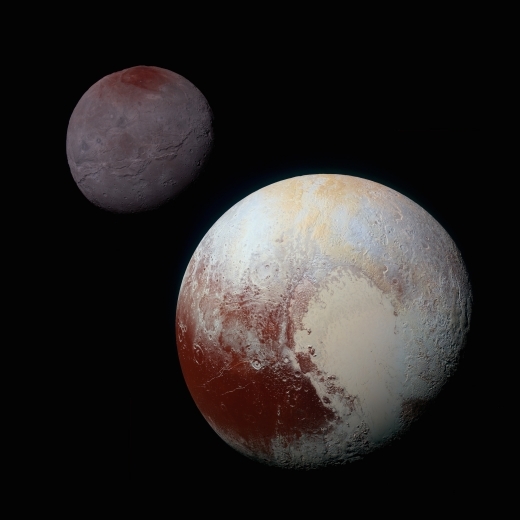
Image: NASA’s New Horizons mission made the first exploration of Pluto-Charon and its system of small moons in 2015. The scientific discoveries led the science community to push for a return to Pluto with an orbiter or to explore other dwarf planets in the Kuiper Belt. Credit: NASA/JHUAPL/SwRI.
The news comes out of a workshop on Pluto and Kuiper Belt exploration held at the American Astronomical Society’s Division for Planetary Sciences meeting in Knoxville, Tennessee. Gravity assists from Charon save propellant, making it possible to continually change the orbiter’s track over Pluto while studying its surface and atmosphere, as well as its system of moons. Several years in such an adjustable orbit would allow us to home in on major discoveries from New Horizons while also uncovering numerous other features that spacecraft did not see.
But it’s also the move into the Kuiper Belt that has Stern’s attention. It makes a Pluto orbiter of this design a multi-purpose spacecraft and leverages our growing experience with ion propulsion. Says Stern:
“This is groundbreaking. Previously, NASA and the planetary science community thought the next step in Kuiper Belt exploration would be to choose between ‘going deep’ in the study of Pluto and its moons or ‘going broad’ by examining smaller Kuiper Belt objects and another dwarf planet for comparison to Pluto. The planetary science community debated which was the right next step. Our studies show you can do both in a single mission: it’s a game changer.”
As analyzed by Tiffany Finley, the orbital tour, still being optimized, would allow dozens of gravity assists at Charon, offering a series of flybys of Pluto’s smaller moons as well as close encounters with Charon itself. Finley talks about studying Pluto’s polar and equatorial regions using plane changes enabled by these maneuvers, including sampling the dwarf planet’s atmosphere. A final Charon gravity assist would take the orbiter into the Kuiper Belt.
And Mark Tapley’s work on electric propulsion ups the ante. He’s arguing that not only would this craft be able to perform flybys of Kuiper Belt objects, but that it could even enter orbit around a second dwarf planet in the Kuiper Belt, just as Ceres followed Vesta for Dawn.
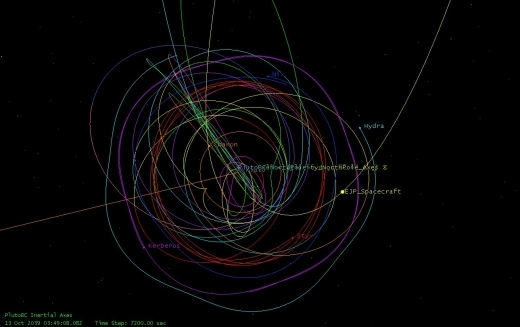
Image: The SwRI-developed Pluto orbital tour design shows scientific objectives can be met with only tiny fuel resources and numerous gravity assists using Pluto’s giant moon Charon. Credit: Southwest Research Institute.
What sort of missions are we talking about? Amanda Zangari’s separate study for this group has looked at the 45 largest Kuiper Belt objects and dwarf planets (covering “the most desirable and scientifically interesting targets”) with launches possible between 2025 and 2040. How these trajectories might be accomplished is presented in a paper that has been accepted by the Journal of Spacecraft and Rockets. From the paper, this is a bit of an eye-opener:
There is a KBO mission possible for every Earth-Jupiter launch window throughout a Jupiter revolution, thus Pluto and every one of the selected 45 KBOs are accessible via Jupiter gravity assist with a flight time of under 25 years and a C3 [excess launch energy] less than 140 km2/s2. Many, but not all objects can be reached via Saturn flyby, and a smaller list still can be compatible with a visit to an ice giant, though it does not necessarily provide a TOF [time of flight] advantage.
Which leads to this:
We found that all five of the non-Pluto KBOs studied by McGranaghan et al [23] can be reached by giant planet swingby— (136199) Eris and (90377) Sedna with Neptune, and (50000) Quaoar, (136472) Makemake and (136108) Haumea via Jupiter-Saturn. Fast-rotator (20000) Varuna is reachable after a Uranus encounter.
Working out the best targets will be critical, for as the paper goes on to note:
We have not considered multiple KBO flybys. It is worth noting that the prospect of an additional flyby of a KBO after Pluto played a large role in New Horizons’ selection, and that it was possible because of Pluto’s proximity at the time to the plane of the Solar System. Many of our KBOs have highly inclined orbits and are often far outside the plane of the Solar System at the time of flyby, thus no additional flybys will be possible en route owing to the vast separations between objects. To probe a second KBO typically requires one to fly through the classical belt.
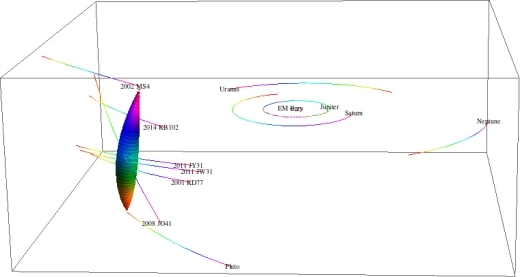
Image: This figure depicts an electric propulsion spacecraft leaving Pluto orbit, flying by other small Kuiper Belt objects and then reaching the dwarf planet 2002 MS4 as just one example of the “gold standard” Pluto orbiter-Kuiper Belt explorer mission discovered by the SwRI study team. Credit: Southwest Research Institute.
We’ll need a good name for the Pluto orbiter/Kuiper Belt explorer mission, so start thinking about it now as we begin hoping that such a mission will be funded. Back to Stern for the conclusion:
“Who would have thought that a single mission using already available electric propulsion engines could do all this? Now that our team has shown that the planetary science community doesn’t have to choose between a Pluto orbiter or flybys of other bodies in the Kuiper Belt, but can have both, I call this combined mission the ‘gold standard’ for future Pluto and Kuiper Belt exploration.”
The team’s paper on spacecraft trajectories at Pluto/Charon and beyond is Zangari et al., “Return to the Kuiper Belt: launch opportunities from 2025 to 2040,” accepted at the Journal of Spacecraft & Rockets (preprint).






October 24, 2018
A Thermal Map of Europa (& an Intriguing Anomaly)
Europa stays in this news this morning as we continue to correlate recent observations with the invaluable results of the Galileo mission. Hubble data have played a role in this, with researchers identifying plume activity in 2013 that recalled the geysers of Enceladus, a possible indication of venting from the subsurface ocean. But analysis of Cassini data from its 2001 Jupiter flyby enroute to Saturn showed no evidence of plume activity through its ultraviolet imaging spectrograph (UVIS).
So what exactly did Hubble see? Yesterday’s post highlighted Julie Rathbun’s contention that if they are there, Europan plumes show no thermal signature in Galileo data, while Xianzhe Jia (University of Michigan) and the SETI Institute’s Melissa McGrath have used Galileo magnetometer data to support possible plume activity. We may need Europa Clipper to resolve the matter.
Now the 66 dish antennas of the Atacama Large Millimeter/submillimeter Array (ALMA) have been turned on Europa in an attempt to study the entire moon — not just the areas of possible plume activity — to develop a thermal model. The data allow us to find what the authors of the paper on this work describe as “significant thermal structure.” What we get out of this is the ability to construct a global map showing the varying heat signatures across this remote world, in the process revealing an unusual cold spot on Europa’s northern hemisphere.
“These ALMA images are really interesting because they provide the first global map of Europa’s thermal emission,” said Samantha Trumbo, a planetary scientist at the California Institute of Technology and lead author on a paper published in the Astronomical Journal. “Since Europa is an ocean world with potential geologic activity, its surface temperatures are of great interest because they may constrain the locations and extents of any such activity.”
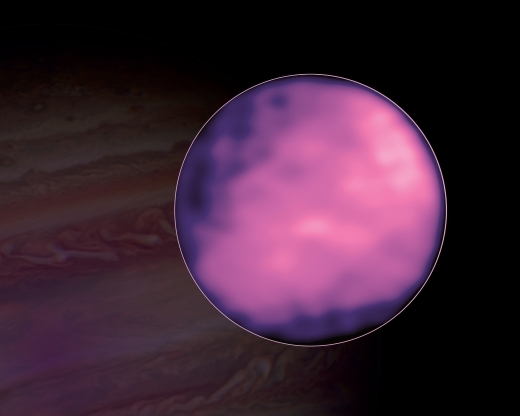
Image: ALMA image of Jupiter’s moon Europa. ALMA was able to map out thermal variations on its surface. Hubble image of Jupiter in the background. Credit: ALMA (ESO/NAOJ/NRAO), S. Trumbo et al.; NRAO/AUI NSF, S. Dagnello; NASA/Hubble.
ALMA’s ability to detect Europa’s thermal ‘glow’ is remarkable given that its surface temperature is never warmer than about minus 160 degrees Celsius, but this is an instrument that can provide insights into not just Jovian moons but asteroids and comets as well. On Europa, ALMA’s images have a resolution of 200 kilometers. Learning more about Europa’s surface can give us insights into its geological processes, especially interesting given that this surface is comparatively young, an indication of thermal or geological activity that has yet to be identified.

Image: Series of 4 images of the surface of Europa taken with ALMA, enabling astronomers to create the first global thermal map of Jupiter’s icy moon. Credit: ALMA (ESO/NAOJ/NRAO), S. Trumbo et al.
Trumbo and colleagues developed their global thermal model of Europa based on the ALMA observations, folding in an albedo map constructed from Voyager measurements and factoring in Galileo data. As for that odd cold spot on Europa’s northern hemisphere, it stands out on the ALMA maps near 90 degrees West and 23 degrees North. It also appears in two different images at two different times of day, an indication that it is genuinely distinct in its thermal properties. Moreover, Galileo may not be able to help us here, as the paper explains:
This region coincides with the location of highest water ice abundance mapped by Brown & Hand (2013) and the location suggested to have the most crystalline water ice by Ligier et al. (2016). However, it does not correspond to any particular geologic unit (Leonard et al. 2017) or any unusual visible morphological or albedo features (USGS 2002). The anomaly is located within a region of relatively low-resolution imaging and was not covered by the published Galileo PPR [Photopolarimeter-Radiometer] data, so it is possible that a corresponding morphological, geologic, or thermal feature was simply not seen by Galileo.
What to make of it? Except for discrepancies like this one, the model the authors work with reproduces the thermal structure seen by ALMA, an indication that we are seeing the results of albedo variation across the surface and the absorption and re-emission of sunlight. However, they find little correlation between the heat signatures and surface geology except for the area around Pwyll crater (this is similar to crater ejecta data elsewhere in the Solar System, which also show a distinctive signature). The cold spot referenced above remains enigmatic and will await future ALMA observations.
An afterword on Pwyll crater, which has been associated with possible plume activity: The ALMA map shows that Pwyll has a “locally elevated thermal inertia.” What this means is that this area takes longer to reach equilibrium with local temperature change than areas around it. Various factors are at play here, including density and thermal conductivity. Of particular interest is that the ‘cold spot’ anomaly is almost directly on the other side of Europa from Pwyll.
There is an analogy here with our own Moon, and the association with geological features on it that are directly opposite, or antipodal, to Tycho crater. But that is about as far as we can go with existing data. “Unfortunately,” the authors write, “without new, high-resolution imaging, the potential association of this feature with unique geology will likely remain an open question.”
The paper is Trumbo et al., “ALMA Thermal Observations of Europa,” Astronomical Journal Vol. 156, No. 4 (18 September 2018). Abstract / Preprint.






October 23, 2018
No Heat Signature of Europan ‘Plumes’
One of the youngest surface features on Europa draws attention because of its possible connection with what lies beneath the Jovian moon’s ice. The dark center of Pwyll crater, visible in the image below, is some 40 kilometers across, with a central peak reaching about 600 meters. At issue is the terrain resulting from the impact causing the crater. An impact perhaps 20 million years ago seems to have blown water and ice across the Europan surface. Evidence of a possible plume from Europa’s ocean in this area is the subject of continuing work.
The bright terrain around the crater suggests water ice, and note, too that the Pwyll impact left ejecta rays as far as the Conamara Chaos region 1000 kilometers to its north. Conamara Chaos features themselves have been studied extensively for terrain suggestive of melting and refreezing ice. We saw recently how Xianzhe Jia (University of Michigan), working with the SETI Institute’s Melissa McGrath, used data from the Galileo mission to support later Hubble evidence of possible plumes on Europa (see Galileo Evidence for Plumes on Europa).

Image: This enhanced color image of the region surrounding the young impact crater Pwyll on Jupiter’s moon Europa was produced by combining low resolution color data with a higher resolution mosaic of images obtained on December 19, 1996 by the Solid State Imaging (CCD) system aboard NASA’s Galileo spacecraft. This region is on the trailing hemisphere of the satellite, centered at 11 degrees South and 276 degrees West, and is about 1240 kilometers across. North is toward the top of the image, and the sun illuminates the surface from the east. The 26 kilometer diameter impact crater Pwyll, just below the center of the image, is thought to be one of the youngest features on the surface of Europa. The diameter of the central dark spot, ejecta blasted from beneath Europa’s surface, is approximately 40 kilometers, and bright white rays extend for over a thousand kilometers in all directions from the impact site. Credit: NASA/JPL-Caltech.
Plumes on Europa would be a momentous discovery, one reason the elusive evidence for their existence is proving so controversial. For if we had active plumes venting seawater from the deep Europan ocean, we could study their composition without the need for landing and drilling through the ice. Europa, like Enceladus, could prove a target for astrobiologically-focused missions in the near future, and indeed, the two researchers I cited above are both associated with the Europa Clipper science team, which will perform multiple flybys of the moon.
This morning we learn that Julie Rathbun (Planetary Science Institute) has dug into the evidence for Europan plumes in a talk titled “A closer look at Galileo Thermal data from possible plume sources near Pwyll, Europa,” with news that makes these plumes more unlikely. For what we would expect at Europa is similar to what we see at Enceladus, the signature of hotspots that flag the energy source driving the plume activity. Similar hotspots can be found on Earth at geysers like Yellowstone and its associated hot springs. But no Europan hotspots can be found.
Rathbun states the issue concisely, so let me just quote her on this:
“We searched through the available Galileo thermal data at the locations proposed as the sites of potential plumes. Reanalysis of temperature data from the Galileo mission does not show anything special in the locations where plumes have possibly been observed. There are no hotspot signatures at either of the sites.”
Such plumes may exist, but appear only rarely. Rathbun continues:
“This is surprising because the Enceladus plumes have a clear thermal signature at their site of origin, so this suggests that either the Europa plumes are very different, or the plumes are only occasional, or that they don’t exist, or that their thermal signature is too small to have been detected by current data.”
Rathbun presented these findings at a Division for Planetary Sciences press conference held at the American Astronomical Society 50th annual meeting in Knoxville, TN. Plume research is ongoing, and bear in mind that the possible plume in the area near Pwyll is not the only one being considered. There is evidence in the Xianzhe Jia and Melissa McGrath work for plume activity about 1,000 kilometers northeast of the first site. Indeed, Jia and McGrath found that magnetic perturbations found by Galileo during its E12 flyby were consistent with a rising plume.
So the jury is still out. If we can get Europa Clipper off, perhaps as early as 2022, its flybys could prove conclusive one way or another. While we wait, analysis and simulations of the interactions between possible plumes and the plasma environment around Europa continue. We have only two Galileo flybys of the Moon containing magnetometer data that came closer than 400 kilometers from the surface, where we might expect a plasma and magnetic field signature if plumes exist, but Europa Clipper will ramp up the magnetic and thermal dataflow considerably.
The Xianzhe Jia paper is “Evidence of a plume on Europa from Galileo magnetic and plasma wave signatures,” published online at Nature Astronomy 14 May 2018 (abstract).






October 22, 2018
Birth of a Supercluster
Long-time Centauri Dreams readers know that I love things that challenge our sense of scale, the kind of comparison that, for example, tells us that if we traveled the distance from the Earth to the Sun, we would have to repeat that distance 268,770 times just to reach the nearest star. It’s much simpler, of course, to say that Proxima Centauri is 4.25 light years from us, but it’s the relating of distances to things that are closer to us that gets across scale, especially for those who are just beginning their astronomical explorations. And I have to admit that the scales involved in going interstellar still pull me up short at times when I ponder them.
So how about this for scale: We have somewhere between 200 billion and 300 billion stars in our galaxy (the number is flexible enough that you’ll see a wide range in the literature). Relate that to the Local Group, the gathering of galaxies that includes both the Milky Way and M31, the Andromeda Galaxy. These are the two most massive members of the Local Group, but depending on how we count dwarf galaxies, it contains more than 30 members spread out over a diameter of 10 million light years. Both the Milky Way and M31 have their own dwarf galaxies.
Then consider the concept of a ‘supercluster,’ which contains galaxy groups within it. Thus the Milky Way is considered part of both the Local Group as well as the Laniakea Supercluster, which is itself home to approximately 100,000 galaxies and subsumes the Virgo Supercluster. The Laniakea Supercluster emerged in the literature in 2014 in a paper examining the relative velocity of galaxies. Laniakea is a Hawaiian word meaning ‘immense heaven.’ R. Brent Tully (University of Hawaii at Manoa) and team identified this structure some 520 million light years in diameter, containing 100,000 galaxies, with a mass of one hundred million billion Suns.
Now a team of astronomers working with data from the European Southern Observatory’s Very Large Telescope (VLT) using its VIMOS (VIsible Multi-Object Spectrograph) instrument has identified a proto-supercluster that formed in the early universe 2.3 billion years after the Big Bang (i.e., its redshift of 2.45 means that astronomers observe it as it was 2.3 billion years after the Big Bang). ESO is describing the discovery, which they have nicknamed Hyperion, as the most massive structure yet found so early in the formation of the Universe.
“This is the first time that such a large structure has been identified at such a high redshift, just over 2 billion years after the Big Bang,” explained the first author of the discovery paper, Olga Cucciati. “Normally these kinds of structures are known at lower redshifts, which means when the Universe has had much more time to evolve and construct such huge things. It was a surprise to see something this evolved when the Universe was relatively young!”
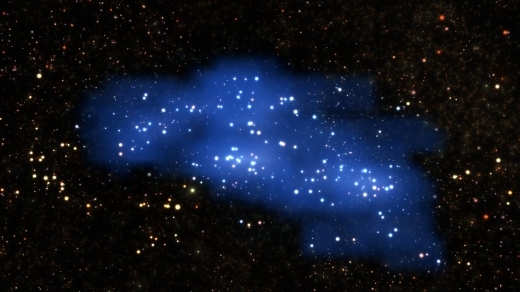
Image: An international team of astronomers using the VIMOS instrument of ESO’s Very Large Telescope have uncovered a titanic structure in the early Universe. This galaxy proto-supercluster — which they nickname Hyperion — was unveiled by new measurements and a complex examination of archive data. This is the largest and most massive structure yet found at such a remote time and distance — merely 2 billion years after the Big Bang. Credit: ESO/Luis Calçada and Olga Cucciati.
Hyperion emerged in the analysis of a field in the constellation Sextans carried out by researchers in the VIMOS Ultra-deep Survey, which has been creating a 3D map of the distribution of over 10,000 galaxies. Hyperion contains seven high-density regions connected by thin ‘filaments’ of galaxies. The average supercluster, says Brian Lemaux (University of California, Davis), an astronomer and co-leader of the team behind this result, shows more concentrated distribution of mass and clear structure. “But in Hyperion,” Lemaux adds, “the mass is distributed much more uniformly in a series of connected blobs, populated by loose associations of galaxies.”
The mass distribution makes sense when you consider that nearby superclusters have had billions of years to create the observed clumping into denser regions with more defined structure. We might expect Hyperion to evolve into something more like the Virgo Supercluster, and studying it should provide insights into how galactic superclusters evolve. It offers a rare glimpse into the early era of supercluster formation, and another signpost of immensity.
What’s ahead for the study of Hyperion? Calling it a “unique possibility to study a rich supercluster in formation 11 billion years ago,” the paper adds this:
This impressive structure deserves a more detailed analysis. On the one hand, it would be interesting to compare its mass and volume with similar findings in simulations, because the relative abundance of superclusters could be used to probe deviations from the predictions of the standard ΛCDM model [Lambda cold dark matter, a model that includes a cosmological constant, dark energy and cold dark matter]. On the other hand, it is crucial to obtain a more complete census of the galaxies residing in the proto-supercluster and its surroundings. With this new data, it would be possible to study the co-evolution of galaxies and the environment in which they reside, at an epoch (z ∼ 2 − 2.5) when galaxies are peaking in their star-formation activity.
The Hyperion findings are being compared to the results of the Observations of Redshift Evolution in Large Scale Environments (ORELSE) survey, led by Lori Lubin (UC-Davis), who was on the team that discovered Hyperion. ORELSE studies superclusters closer to Earth using data from the W.M. Keck Observatory in Hawaii. The next step will be to map out Hyperion in greater detail.
The paper is Cucciati, et al., “The progeny of a Cosmic Titan: a massive multi-component proto-supercluster in formation at z=2.45 in VUDS,” accepted at Astronomy & Astrophysics. Preprint.






October 19, 2018
A Signature of Planetary Migration
Earlier in the week I talked about Astronomy Rewind, an ambitious citizen science project dedicated to recovering old astronomical imagery and digitizing it for comparison with new data. Now I’ve learned that another citizen science effort, Planet Finders, is working with simulated data from the Transiting Exoplanet Survey Satellite (TESS), planning to transition into real TESS data as soon as they become available. Have a look at this effort here if you are interested in becoming a beta tester. TESS will be a hugely significant exoplanet mission particularly in terms of nearby stars, so becoming a part of this project should be an exciting venture indeed.
On with today’s post, which I would have actually run yesterday if I had read the paper soon enough, as it offers insights into Wednesday’s entry on protoplanetary disks. As we’ve seen, these can become the discovery grounds for young planets. In the case of the 2-million year old CI Tau, that meant an already confirmed gas giant in a ‘hot Jupiter’ configuration, along with three other gas giants, two of them far from the central star. Hence the question: Where did the hot Jupiter CI Tau b form? Because if it migrated, it did so early in the history of this system.

Now we have a separate research effort attempting to show that planet migration within a protoplanetary disk can be identified through markers within the disk itself. The idea is to produce an observational marker that can guide future research and tell us whether, within a given system, a planet is moving inward through the disk or staying within its existing orbit.
Image: Astrophysicist Farzana Meru: Credit: University of Warwick.
Lead author Farzana Meru (University of Warwick, UK), working with colleagues at Cambridge University, describes an observational signature in young stellar system dust rings. As with the CI Tau work, the new study involves the Atacama Large Millimeter/submillimeter Array (ALMA), which is able to probe such disks in intricate detail, revealing structure in the form of clumps, gaps, spiral arms, crescents and rings. Even more to the point, by working at different millimeter frequencies, ALMA can identify clustering material in different particle sizes.
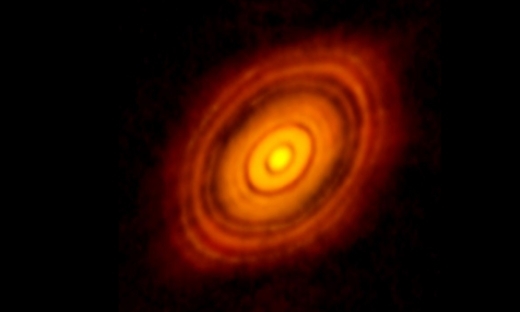
Image: Example of a protoplanetary disk. This is an ALMA image of the young star HL Tau and its disk. The image reveals multiple rings and gaps that herald the presence of emerging planets as they sweep their orbits clear of dust and gas. The image was released Nov. 6, 2014. ALMA (NRAO/ESO/NAOJ); C. Brogan, B. Saxton (NRAO/AUI/NSF).
The question, then, is what can variations in dust particle size tell us? The researchers perform simulations of movement within a ring of gas and dust in the presence of migrating planets of relatively low mass, from 12 to 60 Earth masses. The results show that the gas pressure profile of the disk varies significantly depending on whether the planet is migrating or stationary.
From the paper:
…the pressure perturbation exterior to the planet is weaker while that interior to the planet becomes more important for migrating planets. Dust can therefore be enhanced both interior or exterior to the planet and the result is governed by the relative values of the planet and dust velocities. For small sizes, the dust velocity in the outer disc is too small to keep up with the moving pressure maximum while in the inner disc it moves faster and can collect, forming a dust density enhancement interior to the planet.
For larger dust particles, the dust velocity in the disk exterior to the planet’s orbit is high enough to keep up with the pressure perturbation, producing what the authors describe as a ‘dust density enhancement’ in this region. We would thus expect smaller particles in the interior ring, larger particles in the exterior. By studying the inner and outer rings around the planetary orbit at different wavelengths, we should be able to show whether or not the planet is migrating.
We’re talking about small differences indeed — a migrating planet at 30 AU that is 30 times the mass of the Earth should, according to this modeling, be associated with an inner ring consisting of particles less than a millimeter in size, while those in the outer ring would measure slightly over a millimeter. But this is a workable observable, for as ALMA increases the wavelengths at which it observes, the inner dust ring fades while the exterior ring becomes brighter. This is because the emissivity of dust grains depends on the maximum grain size in the mixture.
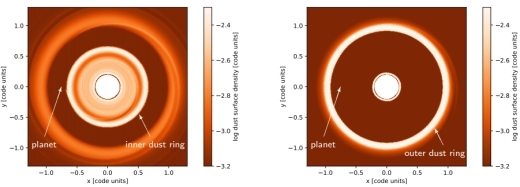
Image: This is the paper’s Figure 7. Caption: “Dust density rendered simulation image of the disc with a 30M⊕ migrating planet at Rp = 0.75 for dust with Stokes numbers of 0.02 (left) and 0.2 (right). The small dust forms a ring interior to the planet while the large dust forms a ring exterior to it.” The ‘Stokes number’ refers to the movement of particles in flow. What is significant here is the separation of small- and large-particle dust accumulations. Credit: Meru et al.
The movement of the dust is the key. In the inner ring, we are seeing smaller particles because these move inwards more slowly than the planet itself, accumulating in the inner ring, while large dust particles are found in the exterior ring because they move at higher velocity than the smaller particles and keep pace with the planet in its movement inward. Over time, the composition of the two rings is distinctive enough to become an ALMA observable.
We’re entering an era when protoplanetary disks are becoming the subject of intense scrutiny thanks to facilities like ALMA, along with the Spectro- Polarimetric High-contrast Exoplanet REsearch (SPHERE) instrument on the Very Large Telescope (VLT) and the Gemini Planet Instrument (GPI) on the Gemini Telescope. And we’re learning that most such disks show sub-structure susceptible to such analysis. We need observational benchmarks like these because a hot Jupiter like CI Tau’s can be the result of migration, but it could also achieve its tight orbit because of gravitational interactions early in the development of the system.
Applying observational constraints to planetary migration could become a potent tool in untangling a young system’s evolution. The work is promising but still in its early stages. In principle, write the researchers, “…it may be possible to use the location of dust rings in order to detect planetary migration, although the feasibility of this measurement is yet to be established.”
The paper is Meru et al., “Is the ring inside or outside the planet?: The effect of planet migration on dust rings,” accepted at Monthly Notices of the Royal Astronomical Society (preprint).






October 18, 2018
Red Dwarfs, ‘Superflares’ and Habitability
Given their ubiquity in the Milky Way, red dwarfs would seem to offer abundant opportunities for life to emerge. But we’re a long way from knowing how habitable the planets that orbit them might be. While mechanisms for moderating the climate on tidally locked worlds in tight habitable zones continue to be discussed, the issue of flares looms large. That makes a new survey of 12 young red dwarfs, and the project behind it, of unusual interest in terms of astrobiology.
What jumps out at the reader of Parke Loyd and team’s paper is the superflare their work caught that dwarfed anything ever seen from our own Sun, a much larger star. It was enough to set Loyd, a postdoctoral researcher at Arizona State University, back on his heels.
“When I realized the sheer amount of light the superflare emitted, I sat looking at my computer screen for quite some time just thinking, ‘Whoa.’” He adds: “With the Sun, we have a hundred years of good observations. And in that time, we’ve seen one, maybe two, flares that have an energy approaching that of the superflare. In a little less than a day’s worth of Hubble observations of these young stars, we caught the superflare. This means that we’re looking at superflares happening every day or even a few times a day.”
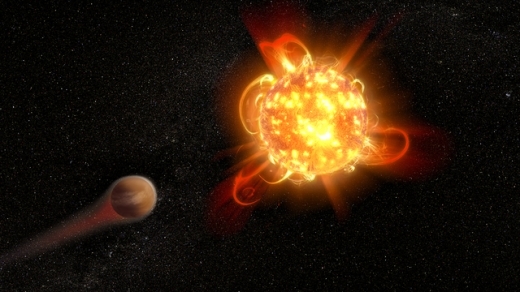
Image: Violent outbursts of seething gas from young red dwarfs may make conditions uninhabitable on fledgling planets. In this artist’s rendering, an active, young red dwarf (right) is stripping the atmosphere from an orbiting planet (left). ASU astronomers have found that flares from the youngest red dwarfs they surveyed — approximately 40 million years old — are 100 to 1000 times more energetic than when the stars are older. They also detected one of the most intense stellar flares ever observed in ultraviolet light — more energetic than the most powerful flare ever recorded from our Sun. Credit: NASA, ESA, and D. Player (STScI)
Loyd’s work is under the aegis of a program called HAZMAT, which stands for HAbitable Zones and M dwarf Activity across Time (ASU’s Evgenya Shkolnik is principal investigator for this project). The issue of time is significant, for HAZMAT will survey young, intermediate and old M-dwarfs using data from the Hubble Space Telescope, and this initial paper focuses on stars that are roughly 40 million years old, mere infants given that this category of star can burn for as long as a trillion years.
As to that superflare, it’s easy to see why it gave Loyd pause. His team detected 18 flares from its 12 target stars, but the superflare swamped them all, emitting 1032.1 erg in the far ultraviolet. That exceeds the most energetic flare from an M-dwarf previously observed by Hubble by a factor of 30.
Have a look at the paper’s description of what the authors call the ‘Hazflare’ in comparison to other flare observations from the past:
This observation is of particular value because superflares are common on stars (e.g., Davenport 2016), yet spectrophotometry of such flares in the UV, the band most relevant to planetary atmospheric photochemistry, is rare. Superflares are estimated from Kepler data to occur on M0–M4 dwarfs at a frequency of a few per day (Yang et al. 2017). Photochemical models exploring the effects of flares on planetary atmospheres have thus far relied primarily on observations of the 1985 Great Flare on AD Leo (Hawley & Pettersen 1991; Segura et al. 2010; Tilley et al. 2017), a flare estimated to emit a bolometric energy of 1034 erg. The Great Flare also showed a clear continuum in FUV emission, and overall the continuum was responsible for at least an order of magnitude more overall energy emitted by the flare than lines, consistent with the Hazflare. However, the Great Flare observations, made with the International Ultraviolet Explorer, saturated in the strongest emission lines, degrading their accuracy.
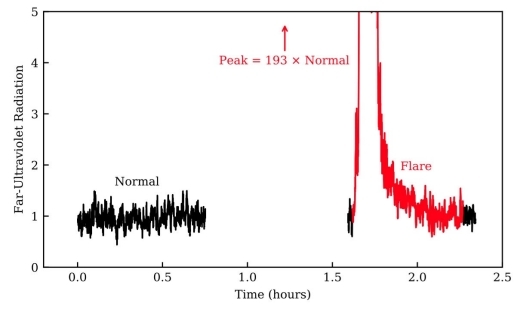
Image: Observations with the Hubble Space Telescope discovered a superflare (red line) that caused a red dwarf star’s brightness in the far ultraviolet to abruptly increase by a factor of nearly 200. Credit: P. Loyd/ASU.
So the HAZMAT observations prove valuable indeed. Superflares like the one described in this paper are far more common in young dwarfs, which can erupt up to 1,000 times more powerfully in their youth than after they have aged, and the Kepler data on their frequency (above) are noteworthy. The mechanism: Strong magnetic fields twisted by the churning atmosphere of the young star, causing them to break and reconnect, a process producing huge amounts of energy. Such violent activity is associated with M-dwarfs in the first 100 million years of their lifetime.
You would think we could just wait out flare activity and assume that older M-dwarfs were our best bet for habitable conditions, but a key question is what kind of damage will already have been done. Pummeling from flares like these could cause atmospheric damage, perhaps even stripping the atmosphere from what might have been promising worlds in the zone where liquid water could exist on the surface. Ultraviolet and X-ray radiation, even if it leaves the atmosphere more or less intact, would also be a huge factor in determining the emergence of surface life, possibly acting as an evolutionary spur or conceivably preventing it from appearing at all.
We also have to learn what processes can replenish the atmosphere of a planet if it undergoes a period of intense UV bombardment followed by a gradually calmer stellar environment. The sheer longevity of red dwarfs gives reason to hope that life could eventually emerge, but we won’t know until we can make the kind of atmospheric observations that will be coming our way through missions like the Transiting Exoplanet Survey Satellite (TESS), the James Webb Space Telescope and the European Space Agency’s ARIEL (Atmospheric Remote-sensing Infrared Exoplanet Large-survey) observatory. The latter, to be launched in 2028, will make a large-scale survey of the chemistry of exoplanet atmospheres using transit methods.
But back to HAZMAT, which will move on next to intermediate-age red dwarfs some 650 million years old, followed by analysis of the radiation environment around much older M-dwarfs. The evolution of that environment will help us refine the target list for the above missions as we focus on star systems more likely to have life. Given that most of the habitable zone planets in the galaxy will have had to withstand high flare activity, we need to make modeling the effects of flare erosion on atmospheres a high priority task.
The paper is Loyd et al., “HAZMAT. IV. Flares and Superflares on Young M Stars in the Far Ultraviolet,” accepted for publication at the Astrophysical Journal (preprint).






October 17, 2018
An Infant System Laden with Gas Giants
We’ve never found a ‘hot Jupiter’ around a star as young as CI Tau. This well studied system, some 2 million years old, has drawn attention for its massive disk of dust and gas, one that extends hundreds of AU from the star. But radial velocity examination recently revealed CI Tau b, a hot Jupiter that in and of itself raises questions. Couple that to the likelihood of three other gas giant planets emerging in the disk with extreme differences in orbital radii and it’s clear that CI Tau challenges our ideas of how gas giants, especially hot Jupiters, emerge and evolve.
Can a hot Jupiter form in place, or is migration from a much more distant orbit the likely explanation? The latter seems likely, and in that case, what was the mechanism here around such a young star? Most hot Jupiter host stars have lost their protoplanetary disks, which means that astronomers have been working with theoretical formation models to produce the observed tight orbits. And because about 1 percent of main sequence solar type stars (CI Tau is a K4IV object) have hot Jupiters around them, the riddle of their formation demands resolution.
The new work on CI Tau comes via high resolution imaging at submillimeter wavelengths at the Atacama Large Millimeter/submillimeter Array (ALMA), where Cathie Clarke (Cambridge Institute of Astronomy) and colleagues have found three distinct gaps in the star’s protoplanetary disk at ∼ 13, 39 and 100 au. The team’s paper in Astrophysical Journal Letters reports on computer modeling showing that these gaps are likely caused by additional gas giant planets.
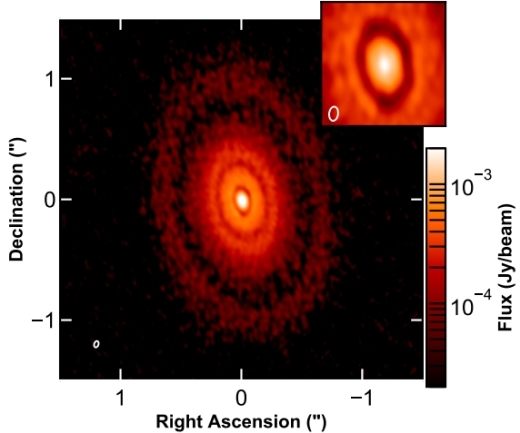
Image: From Figure 1 of the paper, showing the protoplanetary disk around CI Tau. Credit: Clarke et al.
Making the find even more intriguing is that while CI Tau b is in an orbit not dissimilar from Mercury’s, the farthest putative planet orbits at a distance three times that of Neptune. All are large objects — the two outer worlds are roughly the mass of Saturn, while the two inner planets weigh in at 1 Jupiter mass and 10 Jupiter masses for the hot Jupiter. We’re left with the question of how these other planets affected the hot Jupiter’s orbital position, and whether there is a mechanism at work here that could apply to hot Jupiters in other systems.
For that matter, how did the two Saturn-class planets emerge where they are?
“Planet formation models tend to focus on being able to make the types of planets that have been observed already, so new discoveries don’t necessarily fit the models,” said Clarke. “Saturn mass planets are supposed to form by first accumulating a solid core and then pulling in a layer of gas on top, but these processes are supposed to be very slow at large distances from the star. Most models will struggle to make planets of this mass at this distance.”
No doubt. Complicating the picture further is that we have only learned about these planet candidates because of their effects on the protoplanetary disk, so whether or not extreme orbital parameters like these are common in hot Jupiter systems remains an open question. After all, older systems like those we’ve found other hot Jupiters in have already lost their disks.
The Jovian-class worlds may turn out to be easier to explain. Despite CI Tau’s relative youth, the authors argue that its hot Jupiter would still have had time to make the migration into hot Jupiter range. From the paper:
The hot Jupiter… could have been formed by a variety of mechanisms; from the modeled masses in disc and planets and from the accretion on to the star the inferred timescale for its inward migration is ∼ 0.4 Myr (Dürmann & Kley 2015) so that there would have been plenty of time for it to have migrated from a range of outward lying locations. The roughly Jovian mass planet inferred at 14 au is also easy to account for in terms of existing planet formation models (i.e. core accretion models involving either planetesimal or pebble accretion.
But those two outer ‘Saturns’ will need further work. We have a number of planetary disks with well-defined substructure to look at (HL Tau, HD 163296 and HD 169142, among others), but none with a hot Jupiter. Is this orbital configuration one that can survive on billion-year timescales? The authors believe these planets may still end up at small radii, suggesting they could be eventually ejected from the system by gravitational interactions. It will take future imaging surveys to tell us whether systems like the emerging one at CI Tau can be long-lived.
The paper is Clarke et al., “High-resolution Millimeter Imaging of the CI Tau Protoplanetary Disk: A Massive Ensemble of Protoplanets from 0.1 to 100 au,” Astrophysical Journal Letters Vol. 866, No. 1 (4 October 2018). Abstract / preprint.






October 16, 2018
J1407: A New Look at Old Images
It was back in 2012 that Eric Mamajek (University of Rochester) and team discovered a possible ring system around the star J1407 in lightcurves originally taken in 2007, spawning subsequent work with Leiden Observatory’s Matthew Kenworthy. And what a ring system it would be if confirmed. The diameter, based on the lightcurve, would be nearly 120 million kilometers. This would be a ring system nearly 200 times larger than the rings of Saturn, one containing an Earth’s mass of dust particles, and in early studies, one housing over thirty separate rings.
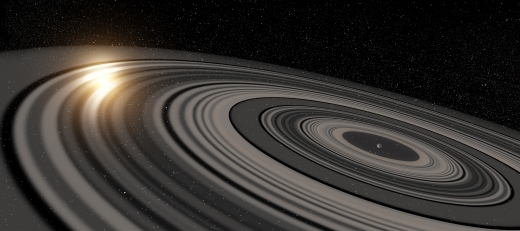
Image: Artist’s conception of the extrasolar ring system circling the young giant planet or brown dwarf J1407b. The rings are shown eclipsing the young sun-like star J1407, as they would have appeared in early 2007. Credit: Ron Miller.
The possible J1407 ring system provides a nice segue from yesterday’s post on recovering astronomical images from a century’s worth of scientific journals, as Centauri Dreams reader Andrew Tribick was quick to note in the comments to that post. For Robin Mentel, working under Kenworthy at Leiden University, has made an analysis of hundreds of photographic plates containing J1407 from 1890 to 1990, finding no eclipses by the planet J1407b. Let’s dig into what that means with the help of a new paper.
Mentel began two years ago studying some 868 photographic plates containing the star, the oldest being data from the Harvard DASCH project (Digital Access to a Sky Century @ Harvard). These results were supplemented with more recent photometry to constrain the orbital period of J1407b. He also examined plates from collections held by Bamberg and Sonneberg observatories, comparing the brightness of J1407 with two equally bright stars nearby. An obscuration by eclipsing planet and rings would dim the star, but no such obscuration was found.
Thus we have useful information to add to what was a remarkable lightcurve, as discussed in a 2015 paper by Kenworthy and Mamajek. Have a look.

Image: From the 2015 paper. The caption reads: “Model ring fit to J1407 data. The image of the ring system around J1407b is shown as a series of nested red rings. The intensity of the colour corresponds to the transmission of the ring. The green line shows the path and diameter of the star J1407 behind the ring system. The grey rings denote where no photometric data constrain the model fit. The lower graph shows the model transmitted intensity I(t) as a function of HJD. The red points are the binned measured flux from J1407 normalised to unity outside the eclipse. Error bars in the photometry are shown as vertical red bars.” Credit: Matthew Kenworthy/Eric Mamajek.
In 2015 I quoted Kenworthy on what the lightcurve seemed to imply:
“The details that we see in the light curve are incredible. The eclipse lasted for several weeks, but you see rapid changes on time scales of tens of minutes as a result of fine structures in the rings. The star is much too far away to observe the rings directly, but we could make a detailed model based on the rapid brightness variations in the star light passing through the ring system. If we could replace Saturn’s rings with the rings around J1407b, they would be easily visible at night and be many times larger than the full moon.”
So what exactly are we dealing with here? The photographic plates allow Mentel and team to calculate how long the period between eclipses might be given gaps in the photographic record. Bear in mind that J1407 is not a circumpolar star, meaning we lack photometric data for more than 50% of the year, when the star was not visible. The paper explains the methodology in detail, including the rejection of numerous plates that lacked reliable photometry of J1407.
Factoring all this in, there remains the possibility of another eclipse between 2021 and 2024, but no guarantees. From the paper:
We cannot confidently rule out any period above 25 years. Since very few plates have been taken before 1900 – 107 years before the 2007 transit – this method effectively cannot rule out any periods above 100 years. We expect the next transit no earlier than Spring 2018 (corresponding to an orbital period of 11 years) and most plausibly between Spring 2021 (orbital period of 14 years) and Spring 2024 (orbital period of 17 years).
And while the new work allows the scientists to exclude a range of orbital periods, it also allows for speculation on the planet’s mass and the shape of its orbit. Moreover, it leaves open the question of what the original observations of 2007 actually recorded:
Elliptical orbits with periastron passage during May 2007 allow a range of possible masses from 5 to 20 MJup and infer an ellipticity of about 0.75. In this case, the rings would fill 70 to 100% of the Hill sphere of [the] companion, and exceed the shrinking hill sphere during periastron by at least a factor of two.
The Hill sphere referred to above is the region within which a planet dominates the attraction of satellites (named after astronomer George William Hill, 1838-1914). In other words, the moon of a planet should lie within the planet’s Hill sphere if the planet is to hold onto it. The paper goes on to make a significant statement about the possible ring detection:
Although the range of orbital periods has been reduced, the lack of the detection of another eclipse means that we still cannot confirm that the eclipse event in 2007 was due to an extended object on a bound orbit around J1407.
If they are there, the rings should show up in continued photometric monitoring of the star, and the authors suggest direct detection of the rings at submillimeter wavelengths by ALMA or at optical wavelengths through the polarization of reflected light from J1407. The broader picture is that we are beginning to put imagery from older observations to work in their newly digitized form. Bear in mind that the DASCH project alone takes in 500,000 photographic plates between 1885 and 1993, and you can see the potential for discovery as well as the immense challenge involved in assembling these materials from observatories and universities all over the world.
The paper is Mentel et al., “Constraining the period of the ringed secondary companion to the young star J1407 with photographic plates,” accepted at Astronomy & Astrophysics (abstract / preprint). The Kenworthy and Mamajek paper from 2015 is “Modeling giant extrasolar ring systems in eclipse and the case of J1407b: sculpting by exomoons?” Astrophysical Journal Vol. 800, No. 2 (abstract / preprint).






October 15, 2018
Reviving Deep Sky Images from the Past
These days we take in data at such a clip that a mission like New Horizons will generate papers for decades. The same holds true for our burgeoning databanks of astronomical objects observed from the ground. So it only makes sense that we begin to recover older datasets, in this case the abundant imagery — photographs, radio maps, telescopic observations — collected in the pre-digital archives of scientific journals. The citizen science project goes by the name Astronomy Rewind, and it’s actively resurrecting older images for comparison with new data.
Launched in 2017, Astronomy Rewind originally classified scans in three categories: 1) single images with coordinate axes; 2) multiple images with such axes; and 3) single or multiple images without such axes. On October 9, the next phase of the project launched, in which visitors to the site can use available coordinate axes or other arrows, captions and rulers to work out the precise location of each image on the sky and fix its angular scale and orientation.
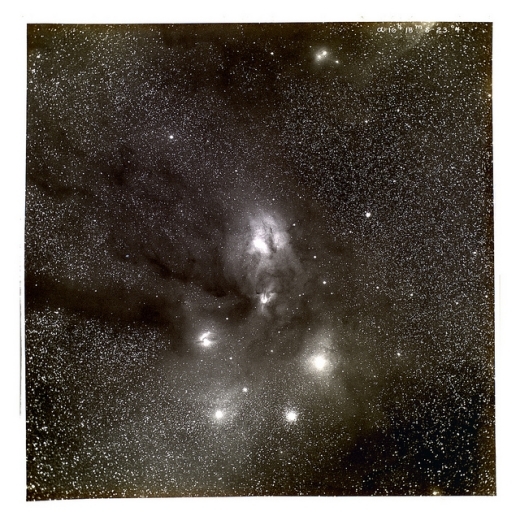
Image: Astronomer E. E. Barnard photographed the Rho Ophiuchi nebula near the border of Scorpius in 1905 through a 10-inch refractor. When he published the image in the Astrophysical Journal five years later, he discussed the possibility — then fiercely debated — that bright nebulae are partially transparent and dark nebulae are opaque, hiding material farther away. Other researchers argued that dark nebulae are simply regions where stars and gas are absent. Credit: American Astronomical Society, NASA/SAO Astrophysics Data System, and WorldWide Telescope.
We have over a century of images to work with, some 30,000 at present drawn from American Astronomical Society journals the Astronomical Journal (AJ), Astrophysical Journal (ApJ), ApJ Letters, and the ApJ Supplement Series. These images were provided through the Astrophysics Data System (ADS), which draws on NASA funding and provides bibliographical and archival services at the Smithsonian Astrophysical Laboratory (SAO), which is part of the Harvard-Smithsonian Center for Astrophysics.
What’s next for the initial round of imagery is inclusion into the WorldWide Telescope. Originally a Microsoft project, the WWT is now managed by the American Astronomical Society, and serves as what the AAS calls a ‘virtual sky explorer that doubles as a portal to the peer-reviewed literature and to archival images from the world’s major observatories.’ 10,000 images (those with coordinate axes) are to be placed within the WWT within a few months, while volunteers proceed to identify where the remaining 20,000 images belong on the sky.
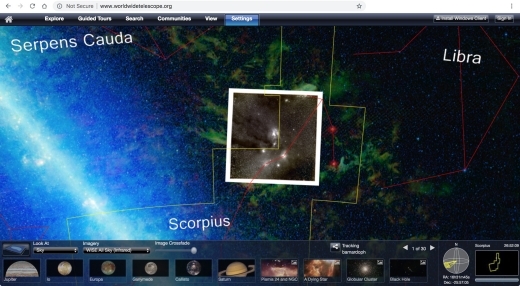
Image: Barnard’s photo has been placed on the sky in its proper position and orientation and is displayed in WorldWide Telescope (WWT) superimposed on a false-color background image from NASA’s Wide-field Infrared Survey Explorer (WISE). Credit: American Astronomical Society, NASA/SAO Astrophysics Data System, and WorldWide Telescope.
But these images are not the only ones arriving for inclusion into the growing database. Results from the related ADS All Sky Survey are also going into the WorldWide Telescope, along with a European image display tool called Aladin, developed at the Centre de Données astronomiques (CDS), Strasbourg Observatory, France. The software highlights the effectiveness of the concept, for with Aladin, users will be able to click on any image that originally appeared in one of the AAS journals and call up the corresponding research paper. Alyssa Goodman, one of the project’s leaders at the Harvard-Smithsonian Center for Astrophysics (CfA), comments:
“Without Astronomy Rewind, astronomers would be unlikely to make the effort to extract an image from an old article, place it on the sky, and find related images at other wavelengths for comparison. Once our revivified pictures are incorporated into WorldWide Telescope, which includes images and catalogs from across the electromagnetic spectrum, contextualization will take only seconds, making it easy to compare observations from a century ago with modern data to see how celestial objects have moved or changed.”
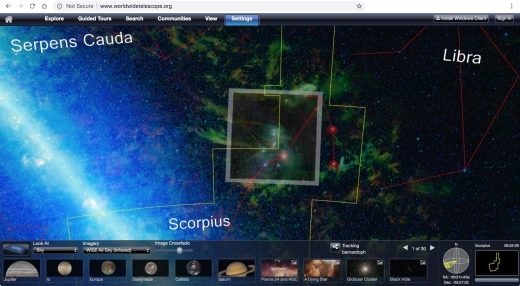
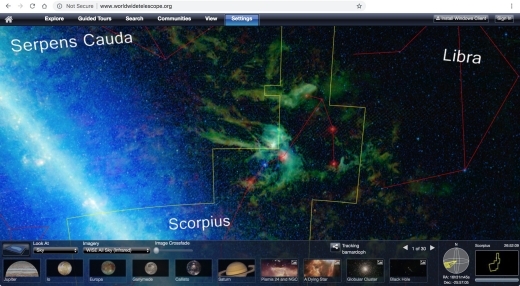
Image: In these two figures, Barnard’s photo has been made partially and fully transparent, respectively, to reveal it in context. In the visible-light photo, gas glows brightly while dust appears in silhouette. In infrared light, as seen by WISE, dust glows brightly where in visible light there was nothing but blackness. Barnard was right! Credit: American Astronomical Society, NASA/SAO Astrophysics Data System, and WorldWide Telescope. Credit: AAS.
As Centauri Dreams readers know, I’ve often enthused about the potential for citizen science projects both in terms of their effectiveness at identifying and cataloging astronomical phenomena as well as the opportunity they present for non-professionals to contribute to fields ranging from deep sky objects to exoplanets and our own Solar System. Astronomy Rewind is clearly keeping the momentum of such efforts going. As it moves into a more challenging phase of confirming the position, scale, and orientation of decades-old astronomical images, the project will offer help features run by astronomy graduate students.
Thus we revive work going back to the 19th Century and link to the work discussing it, with all journal images contextualized on the sky. That’s quite a goal, and it invariably reminds me of the debate over Boyajian’s Star (KIC 8462852, more familiarly known as Tabby’s Star), in which the question of long-term dimming was addressed by a study of 500,000 photographs in the archives of Harvard College Observatory, over a century’s worth of images being digitized through the Digital Access to a Sky Century@Harvard (DASCH) project.
Projects like these are massive in scope and their efforts constitute a heartening work in progress. Ultimately, every astronomical image available in any scientific journal or academic or observatory collection will be catalogued, giving us a way to study the sky over periods of time that are lengthy in comparison to a human lifetime but tiny at the astronomical scale. Nonetheless, KIC 8462852 showed us how an unexpected need to examine old data could propel a scientific debate and flesh out information about a newly discovered mystery.






October 12, 2018
The Farthest: Voyager in Space
As we continue to track the Voyagers into interstellar space, the spacecraft have become the subject of a new documentary. Associate editor Larry Klaes, a long-time Centauri Dreams essayist and commentator, here looks at The Farthest: Voyager in Space, a compelling film released last year. Larry’s deep knowledge of the Voyager mission helps him spot the occasional omission (why no mention of serious problems on the way to Jupiter, or of the historic Voyager 1 photo of Earth and Moon early in the mission?), but he’s taken with the interviews, the special effects and, more often than not, with the spirit of the production. That spirit sometimes downplays science but does give the Golden Record plenty of air-time, including much that was new to me, such as the origin of the “Send more Chuck Berry!” quip, John Lennon’s role, NASA’s ambivalence, and an odd and insulting choice of venue for a key news conference. Read on for what you’ll see and what you won’t in this film about our longest and most distant mission to date.
By Lawrence Klaes
Can one properly represent humanity to the rest of the Milky Way galaxy with just two identical space vessels no bigger than a small school bus and two identical copies of a golden metallic long-playing (LP) record attached to the hulls of said vehicles which contain in their grooves sample images, sounds, languages, and music of their makers and their world?
Our species can only hope so at this point, since the objects in question left Earth over four decades ago and are now tens of billions of miles into deep space heading in different directions through the galaxy. Although primarily planned and built to explore the planets, moons, and rings of the outer Sol system, these vessels were ultimately given another purpose and destiny preordained by their encounters with the places they were sent to. Ironically, this destiny relies on the existence of beings for whom there is as yet no evidence that they are actually out there among the stars.
These records, their carrying vessels and their missions are the focus of the documentary The Farthest: Voyager in Space, which premiered in 2017. Written and directed by Emer Reynolds and produced by John Murray and Clare Stronge for the Irish documentary company Crossing the Line Productions, The Farthest does a masterful artistic job of introducing to generations who were either too young or not yet born to two real space probes on actual missions to alien worlds on a scale never attempted before.

Pioneers and Voyagers, Plaques and Records
The “stars” of The Farthest were originally designated Mariner 11 and 12 by their creators at the National Aeronautics and Space Administration (NASA). They were the descendants of a successful lineage of American deep space probes which had in their ancestry the first visitors to the planets Venus and Mars. However, the space agency wanted to “spice” up their public image and recast these newest members of the Mariner clan as Voyager 1 and 2.
The renaming was appropriate, for these sailors of the interplanetary seas were also descended from what remained of the original Grand Tour plan of the 1960s to examine the outer worlds of the Sol system from Jupiter to Pluto with four nuclear-powered space probes and return unprecedented magnitudes of data about them on a selection of wavelengths.
Launched from Earth in the late summer of 1977, the interplanetary trajectories of the Voyagers past the gas giant worlds would eventually fling them fast enough to permanently escape the gravitational influence of our yellow dwarf star. This would make them only the third and fourth space vessels made by humanity to head towards the interstellar realm after Pioneer 10 and 11, the members of another line of automated American space probes with an impressive exploration pedigree which had celestially paved the way for their more sophisticated brethren just a few years earlier.
The nearly twin Pioneer probes were not only the first spacecraft to visit the planets Jupiter and Saturn between 1973 and 1979, they were also the first to be the recipients of gravitational “slingshots” by those gas giants that sent them towards interstellar space. In case either or both of the probes might one day be found drifting between the stars by sophisticated alien intelligences, each Pioneer carries a small golden plaque attached to their antenna struts. A scientific greeting, the plaques are engraved with basic information on who made these vehicles, what their missions would be, where the probes came from, and when they were lofted into the void.
Recognizing the Voyager missions as two more rare opportunities to preserve and present selected aspects of their species to the wider Milky Way, a small group of professionals from a variety of fields (several of whom were involved with designing the Pioneer Plaques), thinking far ahead, planned and put together a more intricate and detailed “gift package” in the form of a gold-plated copper record. Protected by a thin aluminum cover inscribed with pictogram instructions on how to play it, the Golden Record (as the Voyager Interstellar Record is most often called) contains as much information as could be reasonably etched into the spiraling groove of the 12-inch disc, with over half of the data about the human race being selections of global music.
It has been conservatively estimated that the side of the Golden Records facing outwards (they are bolted to the exteriors of the probes’ main bus) will survive in playable form for at least one billion years in deep space, barring any remote chance of a large cosmic collision or other accident. Hopefully this will be more than enough time for someone to come upon the vessels and their priceless cargo before the galactic environment wears them away to join the rest of its voluminous interstellar dust.
Although the Golden Record was certainly not the main reason for the Voyager missions, they have long since become the prime focus in the public’s mind. After all, the probes’ primary missions ended when Voyager 2 flew through the Neptune system in 1989 and even though they are still functioning and collecting in situ science data on the interstellar medium, that current mission will end around 2030 when their nuclear power supplies can no longer generate enough energy to run any of the instruments. This will leave the Voyagers with its final, singular purpose: To carry that shining circular gift throughout the stars for eons, with the slim but still hopeful possibility that some day another mind in the galaxy will discover it and learn about us.
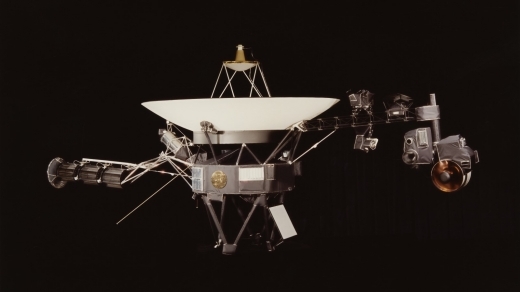
The Farthest as a Whole
The Farthest is a beautifully crafted documentary on a subject that has been waiting a long time for a proper and respectful treatment. Emer Reynolds love for the subject is evident, inspired by childhood visits to her uncle’s farm in Ireland with its night skies free of light pollution, as she described in this interview:
“A fascination with space began on those farm stays. ‘Mohober House’s sky at night was the opposite to the skies over our home in Dublin. We would drive to Tipperary in our old Hillman Hunter, my dad doing maths puzzles with us all the way, just for fun.
“As night fell, the dark, dark skies overhead would reveal the sparkling cosmos. I was dazzled and in awe of the visible smudge of our Milky Way Galaxy overhead.
“I would spend hours lying on the grass, staring into the blackness. I was dreaming of tumbling through space, hurtling along at 67,000 mph, clutching onto a fragile blue planet.
“Aliens, Horse Head Nebula, star nurseries and time-travel, and exotic distant worlds filled my head as a child. They still do in fact.
“The film is a love story to that awe and wonder I first felt as a child in Tipperary,” Reynolds said.
With its under two-hour running time, The Farthest manages to perform quite the balancing act describing the forty-plus year history of how the Voyagers came to be and what they accomplished. This presentation included interviewing nearly two dozen people, most of whom were either directly involved with the development of the space probes and their science missions, or the creation of the Golden Record – and sometimes both. The documentary goes back and forth between the birth, development, launch, and missions of the Voyagers to the four gas and ice giant worlds dominating the outer realm of our celestial neighborhood – Jupiter, Saturn, Uranus, and Neptune – and the parallel development and contents of the Golden Record.
Had Reynolds et al the time and resources, it would have been fascinating to turn The Farthest into a multi-part documentary. For although the production succeeds in giving an excellent introduction to the overall mission, accomplishments, and the people of the Voyager expeditions, each aspect of these deep space probes could have been given their own documentary for a truly in-depth treatment.
As someone who has followed the Voyager probes since their conception in the Grand Tour plan, I was made keenly aware of various important moments in the Voyager history that were left out, no doubt due in large part to time. Each world system visited and revealed by our intrepid robot explorers could easily be given their own dedicated time.
Here is just one example: While the documentary did talk a bit about the true nature of Jupiter’s Galilean moon Europa, first made known to humanity by the Voyagers in 1979, it was literally just skimming the surface on this alien world. Europa has a global ocean of liquid water at twice the volume of all the water found on Earth that is perhaps sixty miles deep and hidden beneath a crust of ice covered in many long lines and cracks and very few impact craters in comparison. It has been speculated that the ruddy material which permeates these fractures in the ice are organic compounds churned up from the ocean below – and perhaps even include the remains of native aquatic life forms.
In regards to the technical aspects of the Voyager probes themselves, when considering how much The Farthest focused on all the technical troubles the twin Voyagers had when they were launched into the Final Frontier for extra dramatic effect, I was disappointed to witness no mention of the serious problems that Voyager 2 had with its radio receivers well before its one and only encounter with Jupiter.
In April of 1978, the space probe’s main radio receiver permanently failed after an unexpected power surge blew its fuses. Thankfully Voyager’s designers had installed a backup receiver which did activate automatically, although it took an entire week for this to happen as mission controllers had to wait for Voyager 2’s onboard computers to recognize that the probe was not receiving any commands from Earth.
Then the team discovered that the backup receiver was having issues of its own, namely that it could not detect changes in radio signal frequencies due to the failure of its “tracking loop capacitor.” As a result, the probe’s human handlers had to determine which frequency that Voyager 2 was listening to and then send commands on the available channel. This situation remained through every one of its planetary encounters right to the present day.
Had both radio systems failed, Voyager 2’s mission would have been effectively over before it had really begun. Both probes were sophisticated enough to conduct a basic science mission on their own in the event they lost contact with their human controllers, but without a way to relay their precious data back to Earth, no one would ever know what the Voyager had found out there. In the particulars of Voyager 2’s case, not only would we have lost its much closer examination of Europa but also humanity’s first encounters with Uranus and Neptune.
Seeing as we have yet to follow up with any new probe missions after Voyager 2’s singular flybys of those ice giants after a time span of over three decades, the loss to planetary science had the robot explorer gone permanently silent while sailing through the Main Planetoid Belt cannot be overestimated.
I was also surprised that the documentary made no mention, let alone failed to even show, one of the first historic actions one of the probes had done during its mission: Just thirteen days after being launched from Cape Canaveral, Florida, Voyager 1 aimed its cameras at the world it had just left and returned the first image of Earth and its moon captured in a single frame from 7.25 million miles away.

This is probably among the more famous images taken by the two deep space probes – and that is saying something. I wish the documenters had shown Earth and the Moon as Voyager 1 saw it while the robotic explorer was just underway on its long journey and then juxtaposed it with the later segment on the probe’s last image taken in February of 1990, the very famous photograph of our planet as a Pale Blue Dot as seen from the edge of our Sol system. This would have made for a nice counterpoint balance, bringing home just how far the Voyagers had gone not only in terms of distance but also in how much they had revealed to and enlightened the species that built them for this adventure, living back there on that blue globe now so far away in space and time.
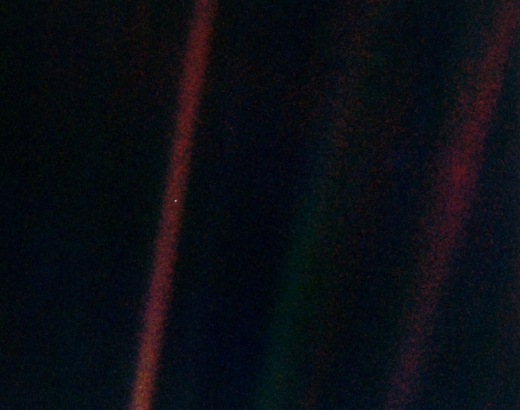
The special effects in The Farthest were very nicely done. One standout in particular involved Voyager 1 sailing in front of Jupiter with its Great Red Spot while they played the eerie, screeching radio signals coming from the giant planet. These literally otherworldly sounds turned out to be immense electrical storms far bigger and more powerful than anything generated on Earth.
I also liked how they introduced the segment for each new planet as the Voyagers approached them for the first time. They took numerous still frames taken by the probes of the world as they were being approached and combined them into a video with subdued music playing in the background. This gave the viewer the feeling of how the mission team felt as the alien globes were slowly being revealed in increasing detail by the probes’ electronic eyes.
Another highlight of The Farthest were the interviews of the people who played both direct and indirect roles with the Voyagers and their Golden Records. Among the many standouts were Frank Locatell, Voyager’s Project Engineer, Mechanical Systems, whose expressive and amusing description of how the team had to surreptitiously wrap all of the probes’ external cables with aluminum foil bought from a local grocery store – so that Jupiter’s immense and powerful magnetic field wouldn’t fry the machines into electronic oblivion — is worth watching the documentary for that alone.
Nick Sagan, the third son of Carl Sagan, the famous astronomer and science popularizer who did much to make the Pioneer Plaques and Voyager Records a reality, shared his experiences and thoughts as a young boy who was asked to participate in the creation of the Golden Record. Among the sound sections on the LP were samples of 55 human languages greeting whoever would find the Voyagers and their gifts some day. Nick represented all those people who speak English with the phrase: “Hello from the children of planet Earth.”
The documentary made a point of mentioning throughout that the Voyager probes were over forty years old, meaning their technology was from the 1970s: The year 1972 to be precise, as the spacecraft designs had to be “frozen” five years before the probes’ launch dates. Perhaps to younger ears this seems positively ancient, leaving them to wonder how anyone back then, even NASA, could send automated spaceships billions of miles across hostile space to explore alien planets and moons in working order for more than a decade.
Rich Terrile, Voyager Imaging Science, visually brought home just how wide the technological gulf had become over the past four decades by producing a modern key fob and saying that the processing power of the computer chip inside this little device was comparable to the most advanced – and much larger – artificial brains of that earlier era.
As a nice counterpoint, this demonstration was immediately followed by a clip with Voyager Project Manager John Casani, who asked: “What’s wrong with ‘70s technology? I mean, you look at me, I’m [19]30s technology!” Casani added that he makes no apologies for the “limitations that we were working with at the time. We milked the technology for what we could get from it.” Seeing how the Voyagers have lasted well beyond their initial planned encounters with Jupiter and Saturn from 1979 to 1981, with every intention of recording and returning scientific data on the interstellar medium for perhaps two decades more, no apologies are necessary, indeed.
Apparently all of the interviews with the Voyager team members and some of the others shown in The Farthest averaged about three hours each. This is yet another reason to have an entire documentary series on the Voyager probes so that those who want to can hear everything these space pioneers accomplished beyond their tantalizing clips. I also hope that the documentary producers have either already archived or will archive these valuable interviews for the benefit of our historical record on the early Space Age.
Too “Space-y Science-y”?
One surprise taken from various interviews and news items regarding The Farthest was the documentary makers’ desire not to get too “space-y science-y” with their presentation. Here is one example of this attitude straight from Emer Reynolds herself:
“We were trying to find people that would be prepared to talk to us, but more than that – because we wanted to make a film that was very human and tapped into the human side as opposed to dry science,” says Reynolds.
The film, she assures, is not aimed at the “space-y science-y types” – it’s for everyone. It is, at its heart, a human story. “It goes into the heart of what makes us human, the great mysteries that define our existence,” says Reynolds.
Not only are “space-y” and “science-y” not actual words in the English language (plus referring to those who do like such topics as “types” is a bit insensitive and ostracizing), but this flies in the face of the fact that the Voyager missions were all about science, not to mention made possible because of science!
I understand to a degree what the documentary makers were trying to say here, as science can be and has been presented by its practitioners in a fashion that is often less than palatable to those who are not indoctrinated in the various fields of knowledge, even including something as naturally exciting and wondrous as outer space. However, such a statement – and a grammatically poor one at that – does not speak well either about the makers’ perceptions of their audience or the knowledge and interest levels of the audiences themselves.
I also understand that they wanted to be inclusive with their viewing audience, but to throw science under the bus like that is not only an offense to the general public but especially those who would be drawn to the subject matter of their documentary because it is both about a historic time in space science and communicating with intelligent extraterrestrial life.
With the exception of the fact that I wish they would turn this documentary into a series to expand upon the various aspects of the Voyager missions, I thought they did a fairly good job of presenting the space science of each world they visited. They even discussed the wild magnetic field of Uranus, a topic that could easily have become bogged down by someone having to explain its physics to a lay audience.
On the other hand, this explains why the documentary’s discussions on ETI were fairly basic, sticking to standard viewpoints and ideas on alien life and their possible behaviors. I cannot say I was entirely pleased with their use of children’s drawings of aliens as background effects. They tended to focus on portraying extraterrestrials as literal bug-eyed monsters and the big-headed, thin-bodied types from innumerable UFO reports. These depictions only serve to infantilize the subject and keep it from being taken seriously by the scientific community and others. Such stereotypical and immature presentations of aliens certainly do not help the case for the existence of the Golden Records.
It is just sad that our culture is so “afraid” of science or anything that might go above their heads, as if they would get lost and confused rather than learn something new to expand and enlighten their worldviews. After all, isn’t that what space exploration is all about? And the Voyagers did that big time. Plus, if we want future generations of those “space-y science-y types” to forge new missions to other worlds in our vast Cosmos, then documenters and educators need to appeal to them to spark their interest and destinies as much as the casually curious viewer, if not more so.
On the Record
The makers of The Farthest worried that too much impersonal science in their documentary would turn away potential viewers, whom they perceived as uncomfortable with the subject matter. In an ironic contrast, a number of the makers and practitioners of the Voyager probes were even more concerned that one particular item being added to the twin vessels were of no scientific value at all.
Jared Lipworth, a consulting producer with HHMI Tangled Bank Studios, which collaborated with the production company Crossing The Line to present The Farthest, stated the situation succinctly in this interview:
“The scientists at the time, a lot of them, did not want to have anything to do with it,” Lipworth said. “They did not want it on [the spacecraft] and didn’t like it was getting all the attention. But that says a lot about humanity. It was as much for us as it was for any alien that might find it.”
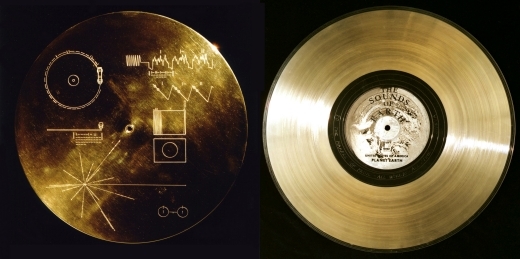
The Farthest provides a good deal of evidence for these reaction to the Golden Records from the scientific and engineering quarters of the Voyager team. Several members confirm this during their interviews, including Frank Drake, the famed SETI pioneer who was also heavily involved with designing both the Pioneer Plaques and the Voyager Records. NASA also showed their ambivalence towards the records: In their early press releases depicting photographs and diagrams of the probes, the Voyagers were often shown with their sides which did not include the familiar disc, as if by hiding the record the space agency could avoid having to discuss it. Being perhaps the most relatable and intriguing aspect of the robotic vessels to the general public, this ploy naturally failed.
The documentary also revealed that the official NASA press conference for the Golden Record was shunted off to a nearby second-rate motel. Held just days after Voyager 2 was lofted skyward, record team member Timothy Ferris relayed how he and his fellow collaborators had to compete with the music and general noise from a Polish wedding going on nearby, separated only by a large partition. The scenario is initially amusing until you grasp just how insulting the whole production was to the record team and the concept. However, as with NASA’s attempts to hide the pesky disc within their media documentation, their efforts at obnubilation were ultimately futile.
The space agency did make one last attempt to physically remove the Golden Record from Voyager. Ferris, who was in charge of procuring the music selections, wanted to include a short engraved dedication message in the blank spaces of the record between its takeout grooves: “To the makers of music – all worlds, all times.” Ferris was inspired to do this by John Lennon of The Beatles, who in turn recommended his studio engineer, Jimmy Iovine, to help with the production of the records.
This seemingly harmless act did not sit well with NASA, as the words were not included in the very detailed specifications for the Voyager probes. The agency was ready to replace the records with blank discs. Only the intervention of Carl Sagan speaking with the NASA Administrator kept the Golden Records attached to their spacecraft. Using a bit of poetry, Sagan pointed out that the dedication was the only example of human handwriting aboard the Voyagers – although it would not surprise me if a few folks snuck in their signatures and perhaps even a note or two during the assembly process. This was and is a common behavior in the history of lunar and planetary exploration.
The Golden Records do indeed have scientific value – certainly to those who may find them one day, but also for humanity itself. They provide a sociological and psychological study of how we may present ourselves to others, in particular others who are highly intelligent but not necessarily human. Then there was the need for developing technologies and sciences to make these presentations viable aboard a spaceship that has to last a very long time drifting in the interstellar medium and remain readable by non-human beings. The records did not need to have a scientific reason to be a part of the Voyager missions despite the protests, but there they are along with several others, no doubt.
For someone like me, who has immersed himself for a lifetime moving about the worlds of science and the humanities/arts, it is hard to imagine how those who can dream of exploring the stars and all their unknowns – plus actually do something to make those dreams a reality – could simultaneously dismiss and even feel embarrassed and hostile to the idea of life elsewhere, including those capable of finding the probe and its shiny metal gift. However, as consulting producer Jeremy Lipworth said, this “says a lot about humanity,” which is the whole point for the existence of the Golden Record.
On the plus side, it was nice to see several Voyager team members defending what was on the Golden Records, in particular how certain images were not offensive despite public opinion and NASA’s concerns about offending those tax payers. This stemmed from the Golden Records’ predecessors, the Pioneer Plaques, which depicted a representation of a male and female human without any clothing upon them. People complained that the space agency was sending “smut” into space among other issues such as the positions of the man’s appendages compared to the woman, who just seemed to be standing there passively.
Having much more room to work with in comparison to the plaques, the Golden Records used this extra space to show any recipients how humans reproduce – within limits, of course. One photograph initially chosen showed a man and woman – nude again – holding hands and smiling at each other. The woman was clearly pregnant, or at least her condition is apparent to any adult human. NASA rejected this image out of fear of more public backlash, so Voyager Record team artist Jon Lomberg had to replace the tasteful photograph with a silhouette of the couple. This replacement at least had the advantage of showing the fetus developing in the woman’s womb as part of the reproduction story.
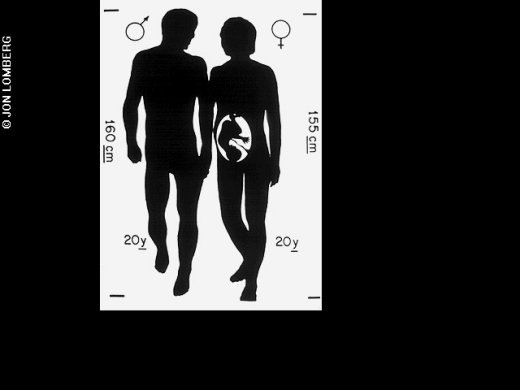
In a bit of irony, while the original photograph of the expectant couple was shown in the theatrical release of The Farthest, when the documentary arrived on PBS Television and elsewhere, someone had replaced the nude man and woman with the Lomberg silhouette! If you must see the original image, it may be found in the official book on the Golden Records titled Murmurs of Earth: The Voyager Interstellar Record (Random House, 1978), authored by all of the main team members. This is a work that anyone interested in communicating with ETI and Space Age history must have in their library. It would be quite interesting to see how our contemporary prudery might affect the understanding of any record recipients when it came to explaining how the beings who made this by-then ancient artifact and its means of transportation also made copies of themselves.
Speaking of changes to The Farthest between its transition from the cinema to the television screen, I noted in the segment on the Pale Blue Dot where there is a vignette depicting various scenes of human activity on Earth, the whole piece was inexplicably removed from the documentary’s presentation on Netflix (it remained intact in its PBS incarnation).
The scene was a nice visual accompaniment on Carl Sagan’s wonderful explanation during a NASA press conference from 1990 of the last image Voyager 1 ever took, less than one year after its twin probe had successfully flown through the Neptune system. A celebration of human life on Earth in a series of wordless images set to music, it shows what we are, the good and the bad, without becoming too graphic in either direction.
This is somewhat ironic, as the Voyager Record team decided early on only to present the Cosmos with our best face forward so as not to inadvertently frighten or offend any recipients with our less sanguine qualities. Only some of the music pieces give hints to the records’ listeners that we are less than ideal, perfect creatures – though they may be able to figure this out anyway just by examining the Voyagers, which will undoubtedly seem incredibly primitive to them, since we assume those who find the space probes will be experts at interstellar travel and detecting small inert alien vessels in the dark and cold of deep space.
As for this unexpected edit to The Farthest, I must wonder if anyone at Netflix consulted with the documentary makers before making this cut, or if they just decided to second-guess the artists’ decision for reasons I do not readily see, either practical or aesthetic. Removing this celebration of the Pale Blue Dot may have done no permanent damage to The Farthest in terms of conveying information about the Voyager missions, but it did diminish a bit what made this documentary a cut above those works which are in essence a dry recitation of facts.
Having pointed out what was removed from The Farthest, this is a good time and place to state my desire for there to have been much more of and about the contents of the Golden Record in the documentary. Naturally they played samples of the record’s actual sounds, voices, images, and music throughout the film: The very first scene displayed a reproduction of part of the letter written by then U.S. President Jimmy Carter specifically for the Golden Record and its recipients. The interview with Nick Sagan gave an illuminating background as to what it was like putting the language segments together, at least in one particular case.
It was also fun to see the Saturday Night Live origin of the joke that any aliens who listened to the record would respond with “Send more Chuck Berry!” given by comedian Steve Martin. Later on we were treated to the amazing moment when, during a celebration of the wildly successful Voyager missions in 1989, both Chuck Berry and Carl Sagan got up together on stage at the Jet Propulsion Laboratory (JPL) in Pasadena, California, singing and dancing to the musician’s hit single, “Johnny B. Goode” – the only representation of rock-and-roll music among the Golden Record’s 27 international songs.
With the highlights of the positive aspects of the Golden Record as shown in The Farthest duty noted, this documentary made me realize just how much I wanted to see far more about that grooved disc and its contents. Just as its story could and did fill an entire book along with countless articles and stories in the intervening years, the Voyager Interstellar Record deserves its own film documentary to do it proper justice in presenting itself to the vast majority of humanity. After all, it was explicitly designed to be our representative to the rest of the Milky Way galaxy, so I say the species that it speaks for should be given the chance to really see the Golden Record should they so desire it.
Of the two hours of samples from humanity and our world, over ninety minutes of the record’s offerings are devoted to global music. The Farthest gave most of its time in regards to the music to Chuck Berry’s landmark song. Certainly at least for Western audiences, “Johnny B. Goode” was probably among the best known of all the record pieces. It also had the benefit of very relevant and entertaining visuals to go with it.
Berry’s pioneering rock-and-roll number was not the only well-known song on the Golden Record, however. Even those who may know little about Ludwig van Beethoven know at least the first few bars of his Fifth Symphony, which are now preserved for eons in deep space. As for my earlier mention of how the record music contains the few indications that humanity is an imperfect species, “Dark Was the Night, Cold Was the Ground” by blues musician Blind Willie Johnson was chosen, in the words of Timothy Ferris in Murmurs of Earth:
“Johnson’s song concerns a situation he faced many times: Nightfall with no place to sleep. Since humans appeared on Earth, the shroud of night has yet to fall without touching a man or woman in the same plight.”
The final song on the Golden Record, which immediately follows Johnson’s number, was another Beethoven piece: The String Quartet No. 13 in B flat, Opus 130, Cavatina. It is a melancholy number made at a particularly dark time in the fading years of the composer’s life. However, this piece of music, like the being and species who made it, is neither simple nor provides simple answers to its meanings, as I quote Ferris once again from Murmurs of Earth:
“But sadness alone can’t define the Cavatina. Strains of hope run through it as well, and something of the serenity of a man who has endured suffering and come to terms with existence perceived without illusion.
“It may be that these ambiguities make for an appropriate conclusion to the Voyager record. We who are living the drama of human life on Earth do not know what measure of sadness or hope is appropriate to our existence. We do not know whether we are living a tragedy or a comedy or a great adventure. The dying Beethoven had no answers to these questions, and knew he had no answers, and had learned to live without them. In the Cavatina, he invites us to stare that situation in the face.”
There was also a recording of the thoughts of Voyager Record team member Ann Druyan conducted on an EEG machine, where she consciously pondered various historical ideas, events, and persons for one hour, along with “the exception of a couple of irrepressible facts” from her life. This part of the record’s development also did not appear in The Farthest, along with the conspicuous absence of Druyan herself. With both Druyan and Carl Sagan largely removed from having a direct influence on the documentary – Sagan passed away in December of 1996 from myelodysplasia, although clips of him conducting earlier interviews permeate the film and provide some measure of his presence there – I was left to wonder how the Golden Record might have been presented had the couple been around for their input, especially together.
The makers of The Farthest emphasized multiple times how much they wanted to bring out the human aspects of the Voyager missions. They did accomplish this, but as my examples have shown, there is so much more that was left untapped by this documentary which needs to be shared with the widest audiences possible. When you are trying to describe a complex and incredibly productive space expedition that is half a century in its making and undertaking in less than two hours aimed at an audience that is curious but not expected to be very knowledgeable about its subject matter, the best you can achieve is a sampler of the Voyager missions.
For those who care, The Farthest can only serve to whet one’s appetite for more. That a full-on documentary series or even a historical film (or mini-series) about the Golden Records has yet to be made after all this time is surprising, given all the depth, drama, and excitement that went into their realization.
I do not count John Carpenter’s 1984 science fiction film Starman as a proper answer to my request. Although it is a well-done film, the Golden Record only serves as the catalyst for the rest of the story. Besides, the film had The Rolling Stone’s 1965 song “(I Can’t Get No) Satisfaction” as part of the music selection on the record, which is patently false. Plus, if the ETI captured Voyager 2 in space in 1984, this would presumably disrupt its mission to the planet Uranus two years later and Neptune three years after that. We did not witness if the aliens released the space probe back onto its flight path, but the visiting ETI’s scout ship was later found on Earth with the Golden Record inside it, thus denying other potential recipients of the Voyager the chance to encounter the disc and its contents, presuming the robotic craft was allowed to continue on its cosmic journey. The aliens interpreted the record’s messages as a peaceful invitation to our world, which they did with a representative of their advanced species – only to have their scout ship and its lone occupant shot down by a missile.
There especially needs to be driven home the fact that Voyager 1 and 2 are now on their final, ultimate mission as ambassadors of Earth and humanity to the rest of the galaxy. Yes, they are still functioning and taking important measurements of the interstellar medium, but the reasons they were sent into space in the first place are now long behind them. What the Voyagers did was both extraordinary and ground-breaking for planetary science, of course, but now other deep space probes have followed in their paths, with more sophisticated instrumentation and revealing data that surpasses their mechanical ancestors. That is the evolution of planetary exploration.
Humanity is a short-lived species, both individually and culturally. Human life spans average about eighty years at present, while we have only had any semblance of a civilized society for roughly six thousand years – mere drops in the cosmic bucket as the phrase goes. The Voyager Records will last for at least one billion years if not much longer even by conservative estimates of their survivability in interstellar space.
To contrast and compare: One billion years ago, Earth’s first multicellular plants were just starting to move onto dry land from the oceans. The evolution of more sophisticated terrestrial creatures were still hundreds of million years in the future. The Voyagers may even survive the demise of Sol and Earth, assuming our planetary system has not already undergone some radical transformation – natural or otherwise – before then.
This is why the actions of a relatively small collection of humans forty years ago to boldly charge into the void called space and simultaneously dare to imagine communicating with unknown alien intelligences in some unimaginable far future time – all with technologies that were becoming obsolete before they even completed their first mission milestones – are an incredible and deeply important story that must be told now and for the edification of our descendants. Sharing our past with our future should and must be done the way the Voyager missions and the Golden Records were put together, as a complimenting fusion of science and artistry.
The Farthest was a very good start, but the tale has hardly even begun.
To see more about this documentary along with the Voyager space probes and the Golden Records, visit the official PBS Television Web site.






Paul Gilster's Blog
- Paul Gilster's profile
- 7 followers



